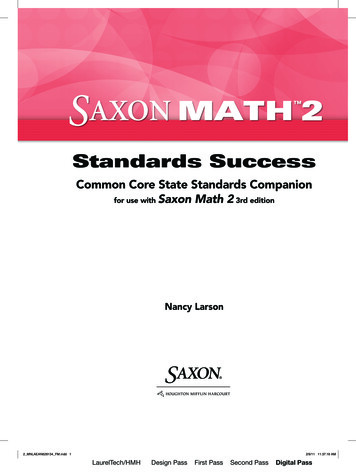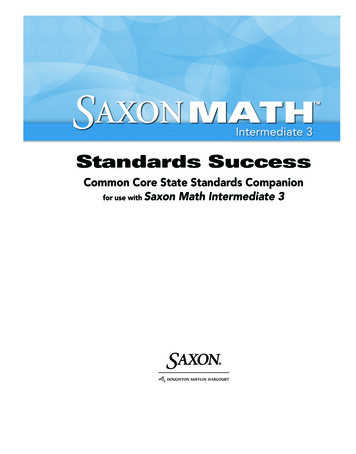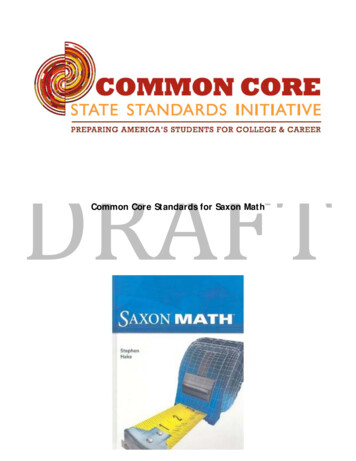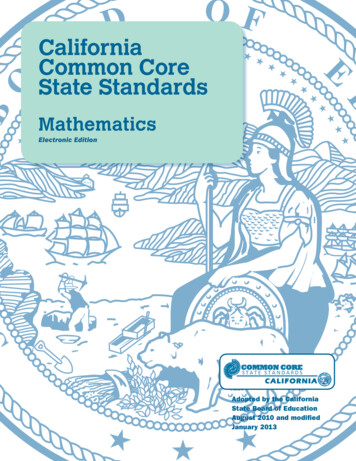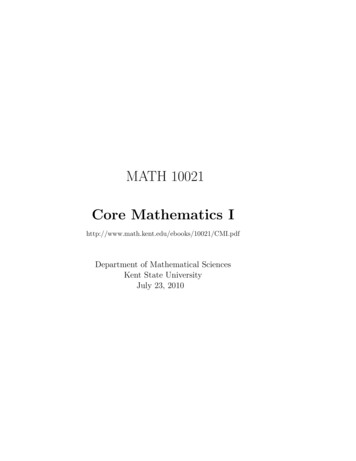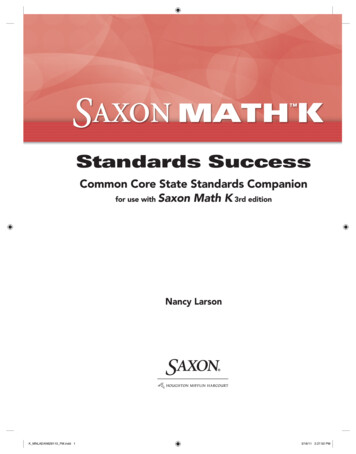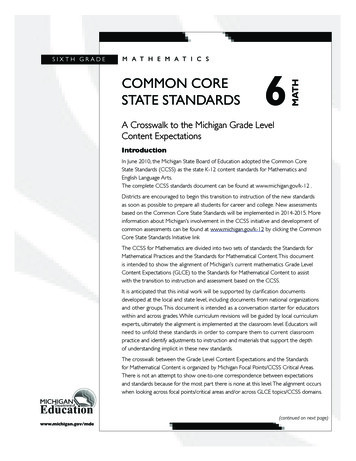
Transcription
M A T H E M A T I C SCOMMON CORESTATE STANDARDS6MATHSIXTH GRADEA Crosswalk to the Michigan Grade LevelContent ExpectationsIntroductionIn June 2010, the Michigan State Board of Education adopted the Common CoreState Standards (CCSS) as the state K-12 content standards for Mathematics andEnglish Language Arts.The complete CCSS standards document can be found at www.michigan.gov/k-12 .Districts are encouraged to begin this transition to instruction of the new standardsas soon as possible to prepare all students for career and college. New assessmentsbased on the Common Core State Standards will be implemented in 2014-2015. Moreinformation about Michigan’s involvement in the CCSS initiative and development ofcommon assessments can be found at www.michigan.gov/k-12 by clicking the CommonCore State Standards Initiative linkThe CCSS for Mathematics are divided into two sets of standards: the Standards forMathematical Practices and the Standards for Mathematical Content. This documentis intended to show the alignment of Michigan’s current mathematics Grade LevelContent Expectations (GLCE) to the Standards for Mathematical Content to assistwith the transition to instruction and assessment based on the CCSS.It is anticipated that this initial work will be supported by clarification documentsdeveloped at the local and state level, including documents from national organizationsand other groups. This document is intended as a conversation starter for educatorswithin and across grades. While curriculum revisions will be guided by local curriculumexperts, ultimately the alignment is implemented at the classroom level. Educators willneed to unfold these standards in order to compare them to current classroompractice and identify adjustments to instruction and materials that support the depthof understanding implicit in these new standards.The crosswalk between the Grade Level Content Expectations and the Standardsfor Mathematical Content is organized by Michigan Focal Points/CCSS Critical Areas.There is not an attempt to show one-to-one correspondence between expectationsand standards because for the most part there is none at this level. The alignment occurswhen looking across focal points/critical areas and/or across GLCE topics/CCSS domains.(continued on next page)www.michigan.gov/mde
Mathematical PracticesThe Standards for Mathematical Practice describe varieties of expertise that mathematics educators at all levelsshould seek to develop in their students. These standards appear in every grade level and are listed below:Mathematical Practices1. Make sense of problems, and persevere in solving them.2. Reason abstractly and quantitatively.3. Construct viable arguments, and critique the reasoning of others.4. Model with mathematics.5. Use appropriate tools strategically.6. Attend to precision.7. Look for, and make use of, structure.8. Look for, and express regularity in, repeated reasoning.Organization of the Common Core State StandardsEach CCSS grade level document begins with a description of the “critical areas.” These Critical Areas are parallelto the Michigan Focal Points. Below is a comparison of the Michigan Focal Points to the Critical Areas for thisgrade.Michigan6th Grade Focal PointsDeveloping an understanding of operations on allrational numbersWriting, interpreting, and using mathematicalexpressions and equations and solving linearequationsCommon Core State Standards6th Grade Critical AreasConnecting ratio and rate to whole numbermultiplication and division and using concepts ofratio and rate to solve problemsCompleting understanding of division of fractionsand extending the notion of number to the systemof rational numbers, which includes negativenumbersWriting, interpreting, and using expressions andequationsDescribing three-dimensional shapes and analyzingtheir properties, including volume and surface areaDeveloping understanding of statistical thinkingThe standards themselves are organized by Domains (large groups that progress across grades) and then byClusters (groups of related standards, similar to the Topics in the Grade Level Content Expectations).Cluster statement2SIXTH GRADEM AT H E M AT I C S M I C H I G A N D E P A R T M E N T O F E D U C A T I O N 12 -2 010
The table below shows the progression of the CCSS domains and clusters across the grade before, the target grade, and the followinggrade.5th Grade6th Grade7th GradeRATIOS AND PROPORTIONAL RELATIONSHIPS (RP) Understand ratio concepts and use ratioreasoning to solve problems.OPERATIONS AND ALGEBRAICTHINKING (OA) Write and interpret numerical expressions. Analyze patterns and relationships.EXPRESSIONS AND EQUATIONS (EE) Apply and extend previous understandingsof arithmetic to algebraic expressions. Use properties of operations to generateequivalent expressions. Reason about and solve one-variableequations and inequalities. Solve real-life and mathematical problems usingnumerical and algebraic expressions andequations. Represent and analyze quantitativerelationships between dependent andindependent variables.NUMBER AND OPERATIONSIN BASE TEN (NBT) Understand the place value system. Perform operations with multi-digit wholenumbers and with decimals to hundredths.NUMBER AND OPERATIONS—FRACTIONS (NF) Use equivalent fractions as a strategy to addand subtract fractions. Analyze proportional relationships and usethem to solve real-world and mathematicalproblems.THE NUMBER SYSTEM (NS) Apply and extend previous understandingsof multiplication and division to dividefractions by fractions. Apply and extend previous understandings ofoperations with fractions to add, subtract,multiply, and divide rational numbers. Compute fluently with multi-digit numbersand find common factors and multiples. Apply and extend previous understandingsof numbers to the system of rationalnumbers. Apply and extend previous understandingsof multiplication and division to multiply anddivide fractions.MEASUREMENT AND DATA (MD)STATISTICS AND PROBABILITY (SP) Convert like measurement units within agiven measurement system. Develop understanding of statisticalvariability. Use random sampling to draw inferences abouta population. Represent and interpret data. Summarize and describe distributions. Draw informal comparative inferences abouttwo populations. Geometric measurement: understandconcepts of volume and relate volume tomultiplication and to addition. Investigate chance processes and develop, use,and evaluate probability models.GEOMETRY (G) Graph points on the coordinate plane tosolve real-world and mathematicalproblems. Classify two-dimensional figures intocategories based on their properties.M AT H E M AT I C S Solve real-world and mathematical problemsinvolving area, surface area, and volume. Solve real-life and mathematical problemsinvolving angle measure, area, surface area, andvolume. Draw, construct and describe geometricalfigures and describe the relationships betweenthem.M I C H I G A N D E P A R T M E N T O F E D U C A T I O N 12 -2 010SIXTH GRADE3
Alignment of Michigan Content Expectations to Common CoreStandards by Michigan Focal PointMichigan Content ExpectationsCommon Core State StandardsFocal PointCritical AreaDeveloping an understanding of operations on allrational numbersConnecting ratio and rate to whole numbermultiplication and division and using concepts ofratio and rate to solve problemsCOMMON CONTENTMathematicalPracticesAdd and subtract integers and rational numbersN.FL.06.10 Add, subtract, multiply, and dividepositive rational numbers fluently. [Core]1. Make sense ofproblems, andpersevere insolving them.Solve decimal, percentage and rational numberproblemsCompute fluently with multi-digit numbers and findcommon factors and multiples6. NS.3 Fluently add, subtract, multiply, and dividemulti-digit decimals using the standard algorithm foreach operation.N.FL.06.14 For applied situations, estimate theanswers to calculations involving operations withrational numbers. [Core]2. Reason abstractlyand quantitatively.3. Construct viablearguments, andcritique thereasoning ofothers.N.FL.06.15 Solve applied problems that use thefour operations with appropriate decimal numbers.[Core]Find equivalent ratios4. Model withmathematics.N.ME.06.11 Find equivalent ratios by scaling up orscaling down. [Core]5. Use appropriatetools strategically.Solve decimal, percentage, and rational numberproblems6. Attend toprecision.N.FL.06.12 Calculate part of a number given thepercentage and the number. [Core]7. Look for, and makeuse of, structure.N.MR.06.13 Solve contextual problems involvingpercentages such as sales taxes and tips. [Extended]8. Look for, andexpress regularityin, repeatedreasoning.Calculate ratesA. PA.06.01 Solve applied problems involving rates,including speed, e.g., if a car is going 50 mph, how farwill it go in 3 1/2 hours? [Core]Convert within measurement systemsM.UN.06.01 Convert between basic units ofmeasurement within a single measurement system,e.g., square inches to square feet1. [Extended]Understand ratio concepts and use ratio reasoning tosolve problems6. RP.2. Understand the concept of a unit rate a/bassociated with a ratio a:b with b 0, and use ratelanguage in the context of a ratio relationship. Forexample, “This recipe has a ratio of 3 cups of flour to4 cups of sugar, so there is 3/4 cup of flour for eachcup of sugar.” “We paid 75 for 15 hamburgers,which is a rate of 5 per hamburger.”6. RP.3. Use ratio and rate reasoning to solvereal-world and mathematical problems, e.g., byreasoning about tables of equivalent ratios, tapediagrams, double number line diagrams, or equations.a. Make tables of equivalent ratios relatingquantities with whole number measurements,find missing values in the tables, and plot thepairs of values on the coordinate plane. Usetables to compare ratios.b. Solve unit rate problems including thoseinvolving unit pricing and constant speed. Forexample, if it took 7 hours to mow 4 lawns, thenat that rate, how many lawns could be mowed in35 hours? At what rate were lawns beingmowed?14SIXTH GRADENot previously linked to a focal point.M AT H E M AT I C S M I C H I G A N D E P A R T M E N T O F E D U C A T I O N 12 -2 010
Michigan Content ExpectationsCommon Core State Standardsc. Find a percent of a quantity as a rate per 100(e.g., 30% of a quantity means 30/100 times thequantity); solve problems involving finding thewhole, given a part and the percent.d. Use ratio reasoning to convert measurementunits; manipulate and transform unitsappropriately when multiplying or dividingquantities.CONTENT THAT IS DIFFERENTContent moving out of 6th gradeAdd and subtract integers and rational numbersN.MR.06.08 Understand integer subtraction as theinverse of integer addition. Understand integerdivision as the inverse of integer multiplication.[Extended]N.FL.06.09 Add and multiply integers between -10and 10; subtract and divide integers using the relatedfacts. Use the number line and chip models foraddition and subtraction. [Core]7th GradeApply and extend previous understandings ofoperations with fractions to add, subtract, multiply, anddivide rational numbers7. NS.1 Apply and extend previous understandingsof addition and subtraction to add and subtractrational numbers; represent addition and subtractionon a horizontal or vertical number line diagram.7. NS.2 Apply and extend previous understandingsof multiplication and division and of fractions tomultiply and divide rational numbers.Content moving into 6th grade5th GradeUnderstand division of whole numbersCompute fluently with multi-digit numbers and findcommon factors and multiplesN.MR.05.06 Divide fluently up to a four-digitnumber by a two-digit number. [Extended]6. NS. 2 Fluently divide multi-digit numbers using thestandard algorithm.Express, interpret, and use ratios; find equivalencesUnderstand ratio concepts and use ratio reasoning tosolve problemsN.ME.05.23 Express ratios in several ways givenapplied situations, e.g., 3 cups to 5 people, 3:5, 3/5;recognize and find equivalent ratios. [Extended]M AT H E M AT I C S 6. RP.1 Understand the concept of a ratio and useratio language to describe a ratio relationshipbetween two quantities. For example, “The ratio ofwings to beaks in the bird house at the zoo was 2:1,because for every 2 wings there was 1 beak.” “Forevery vote candidate A received, candidate C receivednearly three votes.”M I C H I G A N D E P A R T M E N T O F E D U C A T I O N 12 -2 010MathematicalPractices1. Make sense ofproblems, andpersevere insolving them.2. Reason abstractlyand quantitatively.3. Construct viablearguments, andcritique thereasoning ofothers.4. Model withmathematics.5. Use appropriatetools strategically.6. Attend toprecision.7. Look for, and makeuse of, structure.8. Look for, andexpress regularityin, repeatedreasoning.SIXTH GRADE5
Michigan Content ExpectationsCommon Core State StandardsFocal PointCritical AreaDeveloping an understanding of operations on allrational numbersCompleting understanding of division of fractionsand extending the notion of number to the systemof rational numbers, which includes negativenumbersCOMMON CONTENTMultiply and divide fractionsMathematicalPractices1. Make sense ofproblems, andpersevere insolving them.2. Reason abstractlyand quantitatively.3. Construct viablearguments, andcritique thereasoning ofothers.N.MR.06.01 Understand division of fractions as theinverse of multiplication, e.g., if 4/5 2/3 , then(2/3)( ) 4/5 , so (4/5)(3/2) 12/10. [Core]N.FL.06.02 Given an applied situation involvingdividing fractions, write a mathematical statement torepresent the situation. [Core]N.MR.06.03 Solve for the unknown in equationssuch as 1/4 1, 3/4 1/4 , and 1/2 1( ).[Core]N.FL.06.04 Multiply and divide any two fractions,including mixed numbers, fluently. [Core]4. Model withmathematics.6. EE.7 Solve real-world and mathematical problemsby writing and solving equations of the form x p q and px q for cases in which p, q and x are allnonnegative rational numbers.6. Attend toprecision.8. Look for, andexpress regularityin, repeatedreasoning.Focal PointCritical AreaWriting, interpreting, and using mathematicalexpressions and equations and solving linearequationsWriting, interpreting, and using expressions andequationsCOMMON CONTENTUse variables, write expressions and equations, andcombine like termsApply and extend previous understandings ofarithmetic to algebraic expressionsA.FO.06.03 Use letters, with units, to representquantities in a variety of contexts, e.g., y lbs., kminutes, x cookies. [Core]6. EE.2 Write, read, and evaluate expressions inwhich letters stand for numbers.A.FO.06.04 Distinguish between an algebraicexpression and an equation. [Core]6SIXTH GRADE6. NS.1 Interpret and compute quotients offractions, and solve word problems involving divisionof fractions by fractions, e.g., by using visual fractionmodels and equations to represent the problem. Forexample, create a story context for (2/3) (3/4)and use a visual fraction model to show the quotient;use the relationship between multiplication anddivision to explain that (2/3) (3/4) 8/9 because3/4 of 8/9 is 2/3. (In general, (a/b) (c/d) ad/bc.)How much chocolate will each person get if 3people share 1/2 lb of chocolate equally? How many3/4-cup servings are in 2/3 of a cup of yogurt? Howwide is a rectangular strip of land with length 3/4 miand area 1/2 square mi?Reason about and solve one-variable equations andinequalities5. Use appropriatetools strategically.7. Look for, and makeuse of, structure.Apply and extend previous understandings ofmultiplication and division to divide fractions byfractionsM AT H E M AT I C S a. Write expressions that record operations withnumbers and with letters standing for numbers.For example, express the calculation “Subtract yfrom 5” as 5 – y.M I C H I G A N D E P A R T M E N T O F E D U C A T I O N 12 -2 010
Michigan Content ExpectationsA.FO.06.05 Use standard conventions for writingalgebraic expressions, e.g., 2x 1 means “two timesx, plus 1” and 2(x 1) means “two times thequantity (x 1).” [Extended]A.FO.06.06 Represent information given in wordsusing algebraic expressions and equations. [Core]A.FO.06.07 Simplify expressions of the first degreeby combining like terms, and evaluate using specificvalues. [Extended]Represent linear functions using tables, equations,and graphsA.RP.06.08 Understand that relationships betweenquantities can be suggested by graphs and tables.[Extended]A.PA.06.09 Solve problems involving linearfunctions whose input values are integers; write theequation; graph the resulting ordered pairs ofintegers, e.g., given c chairs, the “leg function” is 4c; ifyou have 5 chairs, how many legs?; if you have 12legs, how many chairs? [Extended]A.RP.06.10 Represent simple relationships betweenquantities using verbal descriptions, formulas orequations, tables, and graphs, e.g., perimeter-siderelationship for a square, distance-time graphs, andconversions such as feet to inches. [Extended]Solve equationsA.FO.06.11 Relate simple linear equations withinteger coefficients, e.g., 3x 8 or x 5 10, toparticular contexts and solve. [Core]A.FO.06.12 Understand that adding or subtractingthe same number to both sides of an equationcreates a new equation that has the same solution.[Core]A.FO.06.13 Understand that multiplying or dividingboth sides of an equation by the same non-zeronumber creates a new equation that has the samesolutions. [Core]M AT H E M AT I C S Common Core State Standardsb. Identify parts of an expression usingmathematical terms (sum, term, product, factor,quotient, coefficient); view one or more parts ofan expression as a single entity. For example,describe the expression 2(8 7) as a product oftwo factors; view (8 7) as both a single entityand a sum of two terms.c. Evaluate expressions at specific values for theirvariables. Include expressions that arise fromformulas in real-world problems. Performarithmetic operations, including those involvingwhole-number exponents, in the conventionalorder when there are no parentheses to specifya particular order (Order of Operations). Forexample, use the formulas V s3 and A 6 s2 tofind the volume and surface area of a cube withsides of length s 1/2.6. EE.3 Apply the properties of operations togenerate equivalent expressions. For example, applythe distributive property to the expression 3(2 x)to produce the equivalent expression 6 3x; applythe distributive property to the expression 24x 18y to produce the equivalent expression 6 (4x 3y); apply properties of operations to y y y toproduce the equivalent expression 3y.Reason about and solve one-variable equations andinequalities6. EE.6 Use variables to represent numbers andwrite expressions when solving a real-world ormathematical problem; understand that a variablecan represent an unknown number, or, depending onthe purpose at hand, any number in a specified set.6. EE.7. Solve real-world and mathematicalproblems by writing and solving equations of theform x p q and px q for cases in which p, qand x are all nonnegative rational numbers.M I C H I G A N D E P A R T M E N T O F E D U C A T I O N 12 -2 010MathematicalPractices1. Make sense ofproblems, andpersevere insolving them.2. Reason abstractlyand quantitatively.3. Construct viablearguments, andcritique thereasoning ofothers.4. Model withmathematics.5. Use appropriatetools strategically.6. Attend toprecision.7. Look for, and makeuse of, structure.8. Look for, andexpress regularityin, repeatedreasoning.SIXTH GRADE7
Michigan Content ExpectationsA.FO.06.14 Solve equations of the form ax b c, e.g.,3x 8 15 by hand for positive integer coefficients lessthan 20, use calculators otherwise, and interpret the results.[Extended]MathematicalPractices1. Make sense ofproblems, andpersevere insolving them.2. Reason abstractlyand quantitatively.3. Construct viablearguments, andcritique thereasoning ofothers.Common Core State StandardsRepresent and analyze quantitative relationshipsbetween dependent and independent variables6.EE.9 Use variables to represent two quantities in areal-world problem that change in relationship toone another; write an equation to express onequantity, thought of as the dependent variable, interms of the other quantity, thought of as theindependent variable. Analyze the relationshipbetween the dependent and independent variablesusing graphs and tables, and relate these to theequation. For example, in a problem involving motionat constant speed, list and graph ordered pairs ofdistances and times, and write the equation d 65tto represent the relationship between distance andtime.CONTENT THAT IS DIFFERENTContent moving into 6th grade[Not explicit in Grade Level Content Expectations]Apply and extend previous understandings ofarithmetic to algebraic expressions5. Use appropriatetools strategically.6. EE.4 Identify when two expressions areequivalent (i.e., when the two expressions name thesame number regardless of which value is substitutedinto them). For example, the expressions y y yand 3y are equivalent because they name the samenumber regardless of which number y stands for.6. Attend toprecision.Reason about and solve one-variable equations andinequalities.7. Look for, and makeuse of, structure.6. EE.5 Understand solving an equation or inequalityas a process of answering a question: which valuesfrom a specified set, if any, make the equation orinequality true? Use substitution to determinewhether a given number in a specified set makes anequation or inequality true.4. Model withmathematics.8. Look for, andexpress regularityin, repeatedreasoning.8SIXTH GRADE6. EE.8 Write an inequality of the form x c orx c to represent a constraint or condition in areal-world or mathematical problem. Recognize thatinequalities of the form x c or x c have infinitelymany solutions; represent solutions of suchinequalities on number line diagrams.M AT H E M AT I C S M I C H I G A N D E P A R T M E N T O F E D U C A T I O N 12 -2 010
Michigan Content ExpectationsCommon Core State StandardsFocal PointDescribing three-dimensional shapes and analyzingtheir properties, including volume and surface areaCOMMON CONTENTFind volume and surface areaM.PS.06.02 Draw patterns (of faces) for a cube andrectangular prism that, when cut, will cover the solidexactly (nets). [Core]M.TE.06.03 Compute the volume and surface areaof cubes and rectangular prisms given the lengths oftheir sides, using formulas. [Core]Solve real-world and mathematical problems involvingarea, surface area, and volume6. G.2 Find the volume of a right rectangular prismwith fractional edge lengths by packing it with unitcubes of the appropriate unit fraction edge lengths,and show that the volume is the same as would befound by multiplying the edge lengths of the prism.Apply the formulas V l w h and V b h to findvolumes of right rectangular prisms with fractionaledge lengths in the context of solving real-world andmathematical problems.6. G.4 Represent three-dimensional figures usingnets made up of rectangles and triangles, and use thenets to find the surface area of these figures. Applythese techniques in the context of solving real-worldand mathematical problems.CONTENT THAT IS DIFFERENTContent moving into 6th grade8th GradeSolve problems about geometric figuresSolve real-world and mathematical problems involvingarea, surface area, and volumeG.SR.08.04 Find area and perimeter of complexfigures by sub-dividing them into basic shapes(quadrilaterals, triangles, circles).6. G.1 Find area of right triangles, other triangles,special quadrilaterals, and polygons by composinginto rectangles or decomposing into triangles andother shapes; apply these techniques in the contextof solving real-world and mathematical problems.High SchoolSolve real-world and mathematical problems involvingarea, surface area, and volumeMathematicalPractices1. Make sense ofproblems, andpersevere insolving them.2. Reason abstractlyand quantitatively.3. Construct viablearguments, andcritique thereasoning ofothers.4. Model withmathematics.5. Use appropriatetools strategically.6. Attend toprecision.7. Look for, and makeuse of, structure.8. Look for, andexpress regularityin, repeatedreasoning.6. G.3 Draw polygons in the coordinate plane givencoordinates for the vertices; use coordinates to findthe length of a side joining points with the same firstcoordinate or the same second coordinate. Applythese techniques in the context of solving real-worldand mathematical problems.M AT H E M AT I C S M I C H I G A N D E P A R T M E N T O F E D U C A T I O N 12 -2 010SIXTH GRADE9
Michigan Content ExpectationsCommon Core State StandardsCritical AreaDeveloping understanding of statistical thinkingCOMMON CONTENTNoneCONTENT THAT IS DIFFERENTContent moving into 6th gradeMathematicalPractices1. Make sense ofproblems, andpersevere insolving them.2. Reason abstractlyand quantitatively.3. Construct viablearguments, andcritique thereasoning ofothers.4. Model withmathematics.4th GradeRepresent and solve problems for given dataD.RE.04.02 Order a given set of data, find themedian, and specify the range of values. [Extended]5th GradeFind and interpret mean and mode for a given set ofdataD.AN.05.03 Given a set of data, find and interpretthe mean (using the concept of fair share) and mode.[Core]D.AN.05.04 Solve multi-step problems involvingmeans. [Extended]7th GradeRepresent and interpret data5. Use appropriatetools strategically.D.RE.07.01 Represent and interpret data usingcircle graphs, stem and leaf plots, histograms, andbox-and-whisker plots, and select appropriaterepresentation to address specific questions. [Core]6. Attend toprecision.Compute statistics about data sets7. Look for, and makeuse of, structure.D.AN.07.04 Find and interpret the median,quartiles, and interquartile range of a given set ofdata. [Extended]8. Look for, andexpress regularityin, repeatedreasoning.8th GradeDraw, explain, and justify conclusions based on dataD.AN.08.01 Determine which measure of centraltendency (mean, median, mode) best represents adata set, e.g., salaries, home prices, for answeringcertain questions; justify the choice made.Develop understanding of statistical variability6. SP.1 Recognize a statistical question as one thatanticipates variability in the data related to thequestion and accounts for it in the answers. Forexample, “How old am I?” is not a statistical question,but “How old are the students in my school?” is astatistical question because one anticipates variability instudents’ ages.6. SP.2 Understand that a set of data collected toanswer a statistical question has a distribution whichcan be described by its center, spread, and overallshape.6. SP.3 Recognize that a measure of center for anumerical data set summarizes all of its values with asingle number, while a measure of variation describeshow its values vary with a single number.Summarize and describe distributions6. SP.4 Display numerical data in plots on a numberline, including dot plots, histograms, and box plots.6.SP.5 Summarize numerical data sets in relation totheir context, such as by:a. Reporting the number of observations.b. Describing the nature of the attribute underinvestigation, including how it was measured andits units of measurement.c. Giving quantitative measures of center (medianand/or mean) and variability (interquartile rangeand/or mean absolute deviation), as well asdescribing any overall pattern and any strikingdeviations from the overall pattern withreference to the context in which the data weregathered.d. Relating the choice of measures of center andvariability to the shape of the data distributionand the context in which the data were gathered.10SIXTH GRADEM AT H E M AT I C S M I C H I G A N D E P A R T M E N T O F E D U C A T I O N 12 -2 010
Michigan Content ExpectationsRepresent rational numbers as fractions or decimals2N.ME.06.05 Order rational numbers and placethem on the number line. [Extended]N.ME.06.06 Represent rational numbers asfractions or terminating decimals when possible, andtranslate between these representations. [Extended]N.ME.06.07 Understand that a fraction or anegative fraction is a quotient of two integers, e.g.,- 8/3 is -8 divided by 3. [Extended]Understand rational numbers and their location on thenumber lineN.ME.06.17 Locate negative rational numbers(including integers) on the number line; know thatnumbers and their negatives add to 0, and are onopposite sides and at equal distance from 0 on anumber line. [Extended]N.ME.06.18 Understand that rational numbers arequotients of integers (non zero denominators), e.g., arational number is either a fraction or a negativefraction. [Extended]N.ME.06.19 Understand that 0 is an integer that isneither negative nor positive. [Extended]N.ME.06.20 Know that the absolute value of anumber is the value of the number ignoring the sign;or is the distance of the number from 0. [Extended]Understand the coordinate planeA.RP.06.02 Plot ordered pairs of integers and useordered pairs of integers to identify points in all fourquadrants of the coordinate plane. [Extended]Common Core State StandardsApply and extend previous understandings of numbersto the system of rational numbers6. NS.5 Understand that positive and negativenumbers are used together to describe quantitieshaving opposite directions or values (e.g.,temperature above/below zero, elevation above/below sea level, debits/credits, positive/negativeelectric charge); use positive and negative numbersto represent quantities in real-world contexts,explaining the meaning of 0 in each situation.6. NS.6 Understand a rational number as a point onthe number line. Extend number line diagrams andcoordinate axes familiar from previous grades torepresent points on the line and in the plane withnegative number coordinates.a. Recognize opposite signs of numbers asindicating locations on opposite
4 SIXTH GRADE MATHEMATICS MICHIGAN DEPARTMENT OF EDUCATION 12-2010 MATHEMATICS MICHIGAN DEPARTMENT OF EDUCATION 12-2010 SIXTH GRADE 5 Mathematical Practices 1. Make sense of problems, and persevere in solving t
